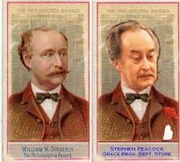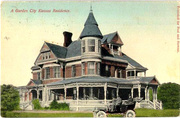In this interview, Ben Crane discusses the origins and evolution of collectible Victorian trade cards, and gives advice to new collectors. Based in Wheaton, Illinois, Crane runs The Trade Card Place, a member of our Hall of Fame.
How did I start collecting Victorian trade cards? In the late 60s I was a bottle collector, early American bottles and flasks. I started noticing there were colorful trade cards that advertised the medicines, often with preposterous claims about their curative powers. You could pick these cards up for 10 cents or so, so I started collecting them with the bottles. I just became more and more interested in the trade cards. I continued collecting bottles for another 15 years but eventually as the bottles became more expensive, I transitioned over to trade cards. So I’ve been collecting them about 40 years.
Collectors Weekly: What’s the story behind Victorian trade cards? How were they originally used and produced?
Crane: They originated in England in the 1700s when tradesmen would advertise their wares, and there are examples in America from the early 1800s. Paul Revere used a trade card to advertise his business. But it wasn’t until the lithographic process came over from Europe in the 1870s that they were able to really mass-produce these cards in color. Lithography is a printing process using various stones with images for each color on each stone and superimposing them to actually print the card.
The golden age of trade cards in the U.S. was probably from 1876 with the Centennial Exposition in Philadelphia to around the early 1900s when halftone printing made it more economical to produce colored advertisements in magazines and newspapers. That signaled the end of lithographed trade cards. Also, mail-order catalogues achieved wider distribution and were more economical.
In terms of the art, very few Victorian trade cards were signed by the artists. They were very good artists, but I think at that time they thought that commercial art was beneath them. Lithography is very technical and detailed and skilled work. That’s one of the things that impressed me, the artistry and the colors these various cards have.
An artist would create the overall picture and then hand it off to the people who would create the different colors for the different stones and then print each card using the stones. They did things backwards so it would look right on the paper. The average cards employed five or so colors, and higher quality cards went up into two dozen or more colors. Just the skill of superimposing all these different stones to get good registration, to make it look like it was just one image is pretty remarkable.
There’s a book published recently by Jay T. Last called “The Color Explosion” which deals with lithography that was done during the 19th Century in America, so for anyone who’s interested, it’s a good reference.
Collectors Weekly: Aside from the art, what else was on the cards?
Crane: Usually one side would have the picture in color or sometimes black and white, and the reverse would have the advertisement. There’s basically two types of cards, one that I refer to as custom cards printed for a specific company and product like Quaker Oats or a certain medicine. Then there are stock cards, printed by the printers who would advertise them for use by other products, typically lower price items. They’d have a pretty girl on it and a dog and a company would decide that they liked that particular image so they’d put their advertisement on it.
With stock cards, the printer would add the advertising on later for the particular company that wanted to use it, but with custom cards they’d just go ahead and print the whole card at once, with the product and the image.
The cards advertised almost anything you can imagine that was for sale at that time. Certainly trade cards were popular for medicines, sewing, and farm equipment, but you can find them for almost any good and service. People who’ve collected trade cards for years and have extensive collections are still discovering new cards they haven’t seen before, and that’s what makes it so interesting. There were a lot of printers who did the cards, the majority tended to be in the East, but there were also printers in the Midwest and some on the West Coast.
Collectors Weekly: Was most of the art similar or did people have their own styles?
Crane: There’s an amazing range of images. A lot of them are comic but there are also some serious illustrations. Unlike coins or stamps, the total production for each card is unknown, and they’re still coming to light in scrapbooks. Every so often I get a call from someone who says they got a scrapbook from their grandmother and they want to know more about it, something that’s been in a closet for 50 years or more. Usually they’ll have some pretty ordinary, common cards, but every once in a while there will be a surprise.
Often you’ll find interesting variations on a similar image. Particularly on the custom cards, sometimes it looks as though a company had different printers use the same basic image and concept to print a card. There’s a Horseshoe Tobacco card, for example, which shows a jockey with a dog and there are probably 8 or 9 variants of this card done by different printers. That’s one of the more interesting aspects of collecting trade cards, it’s interesting to see the subtle changes from one printer to the next.
Collectors Weekly: When did people begin collecting trade cards?
Crane: People started collecting them when they were issued, that was part of the appeal. They were so pretty and the advertisements were so clever that people would get these cards from the stores, take them home and paste them into albums. That’s one of the biggest sources of trade cards right now, these albums that were passed down through the generations. Luckily, they were printed on good quality acid free paper so that they’ve survived over time, and can actually survive being soaked out of the albums depending on what kind of glue was used.
Collectors Weekly: What kinds of trade cards do you collect?
Crane: The metamorphic cards are what attracted me because they were so ingenious, the way the artist could indicate a change just by simply opening or closing a card. The artists were very clever in doing that. I tend to be drawn by the product being advertised, and the overall appeal of the card, the art and colors.
“Clipper Ship cards from the 1860s are considered trade cards, but they’re very rare.”
Cards were sometimes issued in sets, like a set of ten cards for Dr. Kilmer’s medicine, so there’s also that desire to complete a set of cards. Different collectors go for different things, there are people who just collect medicine cards or household cards, but I think there’s a strong pull for people to try and complete sets.
I also prefer American cards. There were some very nice cards printed in Belgium in particular, and some of the people who invented the lithography process in Europe made some really nice cards. Part of the interest for me is the historical aspect, the social history, and the way things were in America in the 1800s, so I that’s why I tend to prefer the American cards.
Collectors Weekly: What big changes have you noticed in your years of collecting trade cards?
When I started out it was mainly antique shops and antique shows, back in the 60s and 70s. I wasn’t aware of ephemera shows or postcard shows, but at an antique show there would often be a dealer somewhere with a box of trade cards and you could usually go through and pick out cards for 10 to 15 cents a piece, 25 cents was a lot and a dollar was an awful lot. Later on the paper shows became more prevalent. In the early 1990s there was a company that started mail order auctions. It’s hard to tell, but I think the collecting hobby has gotten better since the 70s, There’s more shows, primarily on the East Coast. That tends to be where the ephemera action occurs.
Prices have changed a lot, now it’s more like 5 dollars and up, usually 10 dollars and up depending on what they are. Part of that is inflation, but part is an increase in interest. There are a lot more people collecting trade cards now, but the community’s not as big as postcards, and a lot of people haven’t heard of trade cards. When you go to a postcard show, which is one of the sources for trade cards, there will be dealers with a few trade cards, but there’s far more people looking for postcards.
Some rare cards are now worth thousands of dollars. It depends on the scarcity, the subject matter, and the demand. Probably the most expensive are the Clipper Ship cards that advertised Clipper Ships traveling from the East Coast to California in the 1860s. They’re considered to be trade cards but are really a separate category because they’re earlier, and so rare. You don’t see them very often at ephemera shows or in auctions, they tend to be in museums. Also, cards that advertise mechanical banks in color are quite desirable, rare, and expensive. It’s mainly because the people who collect mechanical banks want to have the cards to go along with their banks.
Collectors Weekly: What advice would you have for someone just starting to collect trade cards?
Crane: Collect what you like and what appeals to you. Try to get things in good condition because in a sense it’s an investment. There will be a lot of people who disagree with that, but I’ve always tried to be careful about condition and I think it’s paid off. Go to a lot of shows and look at a lot of cards. eBay of course has become a good source of trade cards, but you have to be a little bit careful with the descriptions and the conditions on things.
In terms of resources, my website has a good list of books, some are out of print but you can probably find them in libraries. Kit Barry put out a book in the early 70s on trade cards, he’s a dealer in ephemera in Vermont. There’s a book by Dave Cheadle called “Victorian Trade Cards” that’s probably the best book for a beginner because it talks about the collecting hobby and gives people a good idea of what the different categories are. It’s out of print, but I think there are copies sometimes available on eBay.
There’s also an organization, The Ephemera Society of America, that has a yearly show in Greenwich, Connecticut, and they have a lot of trade cards along with other ephemera. I don’t know of any specifically trade card collectors organizations out there, which is a void I’m trying to fill with my website.
Collectors Weekly: Anything else you’d like to mention?
Crane: In addition to informative and educational material The Trade Card Place does monthly auctions that are pretty well attended. They are online auctions and I started them around 1998. I’ve been a collector for all these years and I worked for AT&T Bell Laboratories doing software development and when I retired and the Internet came along, I put my interests in trade cards and software together and wrote my own auction software and it’s been pretty successful. I recently completed my 143th auction.
It’s been a way of nourishing the trade card hobby and to provide a way for people to learn about and acquire trade cards. I have customers mostly from America, but some from Canada, England, Japan, Australia, Belgium, and that’s one of the interesting things, people all over the world, via the Internet, are able to look at these trade cards and buy them if they want, I think that’s pretty neat. The Trade Card place is a retirement business slash hobby for me and I enjoy doing it.
(All images in this article courtesy Ben Crane and The Trade Card Place)






 19th-Century Tobacco Cards
19th-Century Tobacco Cards
 Malcolm Warrington Invites You to Learn about Victorian Greeting Cards
Malcolm Warrington Invites You to Learn about Victorian Greeting Cards 19th-Century Tobacco Cards
19th-Century Tobacco Cards When Postcards Were the Social Network
When Postcards Were the Social Network Trade CardsVictorian trade cards are an early form of collectible advertising. Popular…
Trade CardsVictorian trade cards are an early form of collectible advertising. Popular… Victorian EraThe Victorian Era, named after the prosperous and peaceful reign of England…
Victorian EraThe Victorian Era, named after the prosperous and peaceful reign of England… CardsPeople get into card collecting for as many different reasons as there are …
CardsPeople get into card collecting for as many different reasons as there are … Mari Tepper: Laying it on the Line
Mari Tepper: Laying it on the Line Nice Ice: Valerie Hammond on the Genteel Charm of Vintage Canadian Costume Jewelry
Nice Ice: Valerie Hammond on the Genteel Charm of Vintage Canadian Costume Jewelry How Jim Heimann Got Crazy for California Architecture
How Jim Heimann Got Crazy for California Architecture Modernist Man: Jock Peters May Be the Most Influential Architect You've Never Heard Of
Modernist Man: Jock Peters May Be the Most Influential Architect You've Never Heard Of Meet Cute: Were Kokeshi Dolls the Models for Hello Kitty, Pokemon, and Be@rbrick?
Meet Cute: Were Kokeshi Dolls the Models for Hello Kitty, Pokemon, and Be@rbrick? When the King of Comedy Posters Set His Surreal Sights on the World of Rock 'n' Roll
When the King of Comedy Posters Set His Surreal Sights on the World of Rock 'n' Roll How One Artist Makes New Art From Old Coloring Books and Found Photos
How One Artist Makes New Art From Old Coloring Books and Found Photos Say Cheese! How Bad Photography Has Changed Our Definition of Good Pictures
Say Cheese! How Bad Photography Has Changed Our Definition of Good Pictures Middle Earthenware: One Family's Quest to Reclaim Its Place in British Pottery History
Middle Earthenware: One Family's Quest to Reclaim Its Place in British Pottery History Fancy Fowl: How an Evil Sea Captain and a Beloved Queen Made the World Crave KFC
Fancy Fowl: How an Evil Sea Captain and a Beloved Queen Made the World Crave KFC
Congratulations on an outstanding description of your interest and foresight in developing and
Managing such a fascinating hobby and business. You have contributed greatly to the collecting world.
What a great article. Congratulations on turning your passion/interest into something fiscally rewarding as well. I’m proud of you Dad!
Ben has made great information on trade cards accessible for many collectors, both new and seasoned. His contribution to our hobby/passion, through The Trade Card Place, has been invaluable. Great work so far and please keep it up!
I just received a gift of a Trade card copyright 1893 by Buckles Bros. printing….It seems to be a Travel ad for visiting Central Africa.
Who were the printers. Did you ever hear of them, if so where were they located.
Thanks.
I am writing a dissertation on color in the 19th century, and am looking for trade cards illustrating a couple of topics, for use in my dissertation. I was wondering if you have run across trade cards illustrating crazy quilts. I own one; and have lost out on another. I would also be interested in any information you might have on such cards. I am looking for someone who would be willing to let me illustrate his card/cards in my dissertatation, properly credited, of course. Thank you for sharing your expertise! Email: kellyw@one.net
I have a malt bitters advertising card which may not be all that spectacular except it has a puzzle on one side of the card which states ‘find our next president’. There is a White house in the distance and a flora scene, but when the card is turned upside done you see a man’s face. I think it is Ulysses Grant because the image is roughly bearded with a strong nose and bushy eyebrows. Can you give me any information about this card? Thank you
I’ve been researching Sherwoods who lived in Boston: Florence, harp soloist, Harvard B School has one of her cards. Her son, Frederick, had a shirt factory on Washington St. How interesting that a major collector is so close! I’m an antique dealer, have many cards, would eagerly trade for or buy anything about my 2 relatives. Where in Wheaton? Please let me know!
Ben, I started many moons ago to collect cards and sold some cards at victorian images and received all the quarterlies and enjoyed the many articles printed in them. Wish we could have it back. Hope to keep collecting for awhile but expect to sell a lot of my stuff down the road. Thanks for sharing Howard
hello Ben,
greetings from Belgium
I enjoyed reading your interview … keep up the toarch … well done
very instructive for interested collectors
Albert Van den Bosch